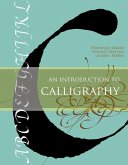Sheila S. Blair (Norma Jean Calderwood University Professor of Isla
Islamic Calligraphy
Sheila S. Blair (Norma Jean Calderwood University Professor of Isla
Islamic Calligraphy
- Broschiertes Buch
- Merkliste
- Auf die Merkliste
- Bewerten Bewerten
- Teilen
- Produkt teilen
- Produkterinnerung
- Produkterinnerung
This stunning book is an important contribution to a key area of non-western art, being the first reference work on the art of beautiful writing in Arabic script.
Andere Kunden interessierten sich auch für
![Abstraction and Calligraphy (English) Abstraction and Calligraphy (English)]() Didier OttingerAbstraction and Calligraphy (English)44,99 €
Didier OttingerAbstraction and Calligraphy (English)44,99 €![Handstyle Lettering: 20th Anniversary Edition: From Calligraphy to Typography Handstyle Lettering: 20th Anniversary Edition: From Calligraphy to Typography]() VictionaryHandstyle Lettering: 20th Anniversary Edition: From Calligraphy to Typography32,99 €
VictionaryHandstyle Lettering: 20th Anniversary Edition: From Calligraphy to Typography32,99 €![The Gift of Calligraphy: A Modern Approach to Hand Lettering with 25 Projects to Give and to Keep The Gift of Calligraphy: A Modern Approach to Hand Lettering with 25 Projects to Give and to Keep]() M Imasaâ stukulsThe Gift of Calligraphy: A Modern Approach to Hand Lettering with 25 Projects to Give and to Keep28,99 €
M Imasaâ stukulsThe Gift of Calligraphy: A Modern Approach to Hand Lettering with 25 Projects to Give and to Keep28,99 €![Brush Pen Calligraphy Brush Pen Calligraphy]() Hamane HigashiBrush Pen Calligraphy17,99 €
Hamane HigashiBrush Pen Calligraphy17,99 €![Pocket Guide to Calligraphy Pocket Guide to Calligraphy]() Joy DanielsPocket Guide to Calligraphy13,99 €
Joy DanielsPocket Guide to Calligraphy13,99 €![An Introduction to Calligraphy An Introduction to Calligraphy]() Veronique SabardAn Introduction to Calligraphy31,99 €
Veronique SabardAn Introduction to Calligraphy31,99 €![A Beginner's Guide to Modern Calligraphy & Brush Pen Lettering A Beginner's Guide to Modern Calligraphy & Brush Pen Lettering]() Maki ShimanoA Beginner's Guide to Modern Calligraphy & Brush Pen Lettering14,99 €
Maki ShimanoA Beginner's Guide to Modern Calligraphy & Brush Pen Lettering14,99 €-
-
-
This stunning book is an important contribution to a key area of non-western art, being the first reference work on the art of beautiful writing in Arabic script.
Produktdetails
- Produktdetails
- Verlag: Edinburgh University Press
- Seitenzahl: 720
- Erscheinungstermin: 23. Oktober 2008
- Deutsch, Englisch
- Abmessung: 247mm x 190mm x 41mm
- Gewicht: 1944g
- ISBN-13: 9780748635405
- ISBN-10: 0748635408
- Artikelnr.: 23450868
- Herstellerkennzeichnung
- Libri GmbH
- Europaallee 1
- 36244 Bad Hersfeld
- gpsr@libri.de
- Verlag: Edinburgh University Press
- Seitenzahl: 720
- Erscheinungstermin: 23. Oktober 2008
- Deutsch, Englisch
- Abmessung: 247mm x 190mm x 41mm
- Gewicht: 1944g
- ISBN-13: 9780748635405
- ISBN-10: 0748635408
- Artikelnr.: 23450868
- Herstellerkennzeichnung
- Libri GmbH
- Europaallee 1
- 36244 Bad Hersfeld
- gpsr@libri.de
Sheila S. Blair
List of Figures
List of Abbreviations
Glossary
Index
Part I: Introduction
Chapter 1: Arabic Script: Its Role and Principles
Chapter 2: Materials
Part II: The Development of Arabic Script in Early Islamic Times
Chapter 3: The Standardization of Arabic Script
Chapter 4: Early Manuscripts of the Koran
Part III: The Pre-Eminence of Round Scripts in the Early Middle Period
Chapter 5: The Adoption of Round Scripts
Chapter 6: The Proliferation of Round Scripts
Part IV: The Emergence of Regional Styles in the Later Middle Period
Chapter 7: Calligraphy in Iran and its Environs under the Mongols and
Turkomans
Chapter 8: Rectilinear and Curvilinear Scripts in Egypt and Syria under the
Mamluks
Chapter 9: Other Styles and Centers
Part V: Dynastic Styles in the Age of Empires
Chapter 10: The Safavids, the Qajars, and their Contemporaries in Iran and
Central Asia
Chapter 11: The Ottomans in Anatolia, the Balkans, and the Eastern
Mediterranean
Chapter 12: Other Styles and Centers
Part VI: The Many Faces of Islamic Calligraphy in Modern Times
Chapter 13: From Traditional Styles to Graphic Design and Calligraphic Art
Bibliography
Copyright Acknowledgements
Index
List of Abbreviations
Glossary
Index
Part I: Introduction
Chapter 1: Arabic Script: Its Role and Principles
Chapter 2: Materials
Part II: The Development of Arabic Script in Early Islamic Times
Chapter 3: The Standardization of Arabic Script
Chapter 4: Early Manuscripts of the Koran
Part III: The Pre-Eminence of Round Scripts in the Early Middle Period
Chapter 5: The Adoption of Round Scripts
Chapter 6: The Proliferation of Round Scripts
Part IV: The Emergence of Regional Styles in the Later Middle Period
Chapter 7: Calligraphy in Iran and its Environs under the Mongols and
Turkomans
Chapter 8: Rectilinear and Curvilinear Scripts in Egypt and Syria under the
Mamluks
Chapter 9: Other Styles and Centers
Part V: Dynastic Styles in the Age of Empires
Chapter 10: The Safavids, the Qajars, and their Contemporaries in Iran and
Central Asia
Chapter 11: The Ottomans in Anatolia, the Balkans, and the Eastern
Mediterranean
Chapter 12: Other Styles and Centers
Part VI: The Many Faces of Islamic Calligraphy in Modern Times
Chapter 13: From Traditional Styles to Graphic Design and Calligraphic Art
Bibliography
Copyright Acknowledgements
Index
List of Figures
List of Abbreviations
Glossary
Index
Part I: Introduction
Chapter 1: Arabic Script: Its Role and Principles
Chapter 2: Materials
Part II: The Development of Arabic Script in Early Islamic Times
Chapter 3: The Standardization of Arabic Script
Chapter 4: Early Manuscripts of the Koran
Part III: The Pre-Eminence of Round Scripts in the Early Middle Period
Chapter 5: The Adoption of Round Scripts
Chapter 6: The Proliferation of Round Scripts
Part IV: The Emergence of Regional Styles in the Later Middle Period
Chapter 7: Calligraphy in Iran and its Environs under the Mongols and
Turkomans
Chapter 8: Rectilinear and Curvilinear Scripts in Egypt and Syria under the
Mamluks
Chapter 9: Other Styles and Centers
Part V: Dynastic Styles in the Age of Empires
Chapter 10: The Safavids, the Qajars, and their Contemporaries in Iran and
Central Asia
Chapter 11: The Ottomans in Anatolia, the Balkans, and the Eastern
Mediterranean
Chapter 12: Other Styles and Centers
Part VI: The Many Faces of Islamic Calligraphy in Modern Times
Chapter 13: From Traditional Styles to Graphic Design and Calligraphic Art
Bibliography
Copyright Acknowledgements
Index
List of Abbreviations
Glossary
Index
Part I: Introduction
Chapter 1: Arabic Script: Its Role and Principles
Chapter 2: Materials
Part II: The Development of Arabic Script in Early Islamic Times
Chapter 3: The Standardization of Arabic Script
Chapter 4: Early Manuscripts of the Koran
Part III: The Pre-Eminence of Round Scripts in the Early Middle Period
Chapter 5: The Adoption of Round Scripts
Chapter 6: The Proliferation of Round Scripts
Part IV: The Emergence of Regional Styles in the Later Middle Period
Chapter 7: Calligraphy in Iran and its Environs under the Mongols and
Turkomans
Chapter 8: Rectilinear and Curvilinear Scripts in Egypt and Syria under the
Mamluks
Chapter 9: Other Styles and Centers
Part V: Dynastic Styles in the Age of Empires
Chapter 10: The Safavids, the Qajars, and their Contemporaries in Iran and
Central Asia
Chapter 11: The Ottomans in Anatolia, the Balkans, and the Eastern
Mediterranean
Chapter 12: Other Styles and Centers
Part VI: The Many Faces of Islamic Calligraphy in Modern Times
Chapter 13: From Traditional Styles to Graphic Design and Calligraphic Art
Bibliography
Copyright Acknowledgements
Index








